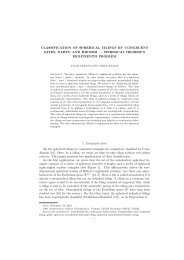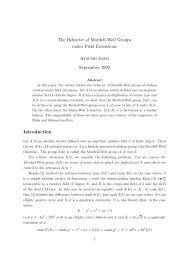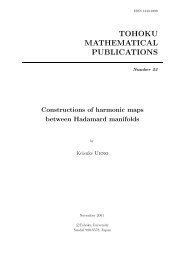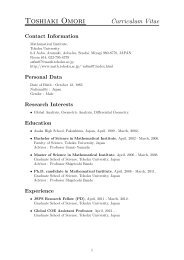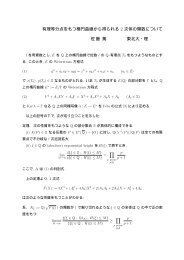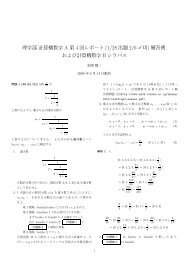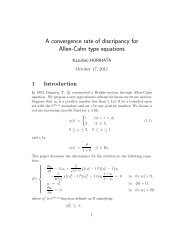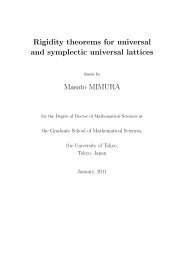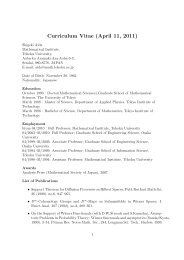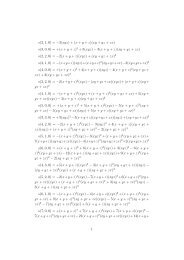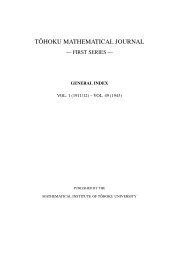Pseudo-Anosovs with small entropy and the magic 3-manifold E. Kin ...
Pseudo-Anosovs with small entropy and the magic 3-manifold E. Kin ...
Pseudo-Anosovs with small entropy and the magic 3-manifold E. Kin ...
You also want an ePaper? Increase the reach of your titles
YUMPU automatically turns print PDFs into web optimized ePapers that Google loves.
<strong>Pseudo</strong>-<strong>Anosovs</strong> <strong>with</strong> <strong>small</strong> <strong>entropy</strong> <strong>and</strong> <strong>the</strong><strong>magic</strong> 3-<strong>manifold</strong>E. <strong>Kin</strong> ∗ M. TakasawaWorkshop Simplicial Complexes Arising in Low-DimensionalTopology2009.07.02-03
<strong>Pseudo</strong>-<strong>Anosovs</strong> <strong>and</strong> <strong>the</strong> <strong>magic</strong> <strong>manifold</strong> (2009.07.2) 2/ 25Mapping class groupsΣ = Σ g,n ; an orientable surface of genus g <strong>with</strong> n puncturesM(Σ); <strong>the</strong> mapping class group on Σ• A classification of mapping classes φ ∈ M(Σ) (Thurston)(1) reducible, (2) periodic, (3) pseudo-Anosov (pA)
<strong>Pseudo</strong>-<strong>Anosovs</strong> <strong>and</strong> <strong>the</strong> <strong>magic</strong> <strong>manifold</strong> (2009.07.2) 3/ 25Properties of pseudo-<strong>Anosovs</strong>Fact. (Miller, Thurston)φ ∈ M(Σ) is pA⇐⇒ φ n (c) ≠ c for any essential loop c in Σ <strong>and</strong> for any n > 0⇐⇒ mapping torus T(φ) = Σ × [0, 1]/ (x,0)∼(Φ(x),1) is hyperbolic
<strong>Pseudo</strong>-<strong>Anosovs</strong> <strong>and</strong> <strong>the</strong> <strong>magic</strong> <strong>manifold</strong> (2009.07.2) 4/ 25• Fix a hyperbolic metric m on Σ.Fact. Let φ ∈ M(Σ) be pseudo-Anosov.for any essential simple loop c in Σ,∃1 λ = λ(φ) > 1 such thatwhere l m (·) is <strong>the</strong> length of (·).λ = limn→∞ l m(φ n (c)) 1/n ,• λ(φ) > 1 is called <strong>the</strong> dilatation of φ.Question. How do you compute λ = λ(φ)?• Compute <strong>the</strong> transition matrix M (incident matrix) for <strong>the</strong> train track map ofφ. Then <strong>the</strong> largest eigenvalue of M equals λ(φ). (Thurston, Penner, Bestvina-H<strong>and</strong>el....)
<strong>Pseudo</strong>-<strong>Anosovs</strong> <strong>and</strong> <strong>the</strong> <strong>magic</strong> <strong>manifold</strong> (2009.07.2) 5/ 25pseudo-Anosov braids• Σ = D n ; an n-punctured disk.• B n : n-braid group• ∃ Γ : B n → M(D n ) a homomorphism.• b ∈ B n is said to be pseudo-Anosov if Γ(b) is a pA mapping class.• For a braid b, one defines <strong>the</strong> braided link b.• mapping torus T(Γ(b)) is homeomorphic to S 3 \ b.bb
<strong>Pseudo</strong>-<strong>Anosovs</strong> <strong>and</strong> <strong>the</strong> <strong>magic</strong> <strong>manifold</strong> (2009.07.2) 6/ 25Two invariants of pA1. volume vol(φ) := volume of <strong>the</strong> mapping torus T(φ)2. dilatation λ(φ) or <strong>entropy</strong> ent(φ) = log(λ(φ))Fixing a surface Σ,λ(Σ) := min{λ(φ) | φ ∈ M(Σ)},vol(Σ) := min{vol(φ) | φ ∈ M(Σ)}.• It is hard to compute <strong>the</strong> minimal dilatation <strong>and</strong> minimal volume.
<strong>Pseudo</strong>-<strong>Anosovs</strong> <strong>and</strong> <strong>the</strong> <strong>magic</strong> <strong>manifold</strong> (2009.07.2) 7/ 25Qeustion. Are <strong>the</strong>re any relation between <strong>the</strong> two invariants vol(φ) <strong>and</strong>ent(φ)?Yes!Fact. Fix a surface Σ. Then ∃ B = B(Σ) such that ent(φ) ≥ Bvol(φ)for any pA φ ∈ M(Σ).(1) ent(φ) = ||φ|| T .(2) D −1 vol(φ) ≤ ||φ|| W P ≤ D vol(φ), ( ∃ D = D(Σ)) (Brock)(3) C||φ|| T > ||φ|| W P , ( ∃ C = C(Σ)) (Royden)
Magic <strong>manifold</strong>• n-chain link C n<strong>Pseudo</strong>-<strong>Anosovs</strong> <strong>and</strong> <strong>the</strong> <strong>magic</strong> <strong>manifold</strong> (2009.07.2) 8/ 25non-alternating• They are an important examples for <strong>the</strong> study of exceptional Dehn surgery• M <strong>magic</strong> := S 3 \ (3-chain link C 3 )(1) <strong>small</strong>est known volume among ori. 3-<strong>manifold</strong>s having 3 cusps.(2) some <strong>manifold</strong>s having at most 2 cusps <strong>with</strong> <strong>small</strong> volume are obtained fromM <strong>magic</strong> by Dehn fill. (figure 8 knot, whitehead link, whitehead sister link etc)
Families of braids<strong>Pseudo</strong>-<strong>Anosovs</strong> <strong>and</strong> <strong>the</strong> <strong>magic</strong> <strong>manifold</strong> (2009.07.2) 9/ 25• β m,n <strong>and</strong> ̂β m,nm n m n• β m,n is obtained from ̂β m,n by forgetting two str<strong>and</strong>s• <strong>the</strong>se braids are pseudo-Ansovs for all m, n ≥ 1 (Hironaka-K)
<strong>Pseudo</strong>-<strong>Anosovs</strong> <strong>and</strong> <strong>the</strong> <strong>magic</strong> <strong>manifold</strong> (2009.07.2) 10/ 254-chain link• L c = L ′ means that S 3 \ L = S 3 \ L ′Lemma 1. For each m, n ≥ 1, we have(1) (braided link of β b m,n ) = c C 4(2) (braided link of β m,n ) is obtained from S 3 \ C 4 by a Dehn filling.Proof. See <strong>the</strong> picture.cc
Dilatation<strong>Pseudo</strong>-<strong>Anosovs</strong> <strong>and</strong> <strong>the</strong> <strong>magic</strong> <strong>manifold</strong> (2009.07.2) 11/ 25Proposition 1 (Takasawa-K).lim λ(β m,n) =m,n→∞lim λ(̂β m,n ) = 1m,n→∞
<strong>Pseudo</strong>-<strong>Anosovs</strong> <strong>and</strong> <strong>the</strong> <strong>magic</strong> <strong>manifold</strong> (2009.07.2) 12/ 25• efficient graph map (Bestvina-H<strong>and</strong>el 1994)• transition matrix M = (m i,j )m i,j = ♯ of times that φ(e i ) (image of edge e i ) crosses e j• λ(β m,n ) = λ( b β m,n ) = <strong>the</strong> largest eigenvalue of M
<strong>Pseudo</strong>-<strong>Anosovs</strong> <strong>and</strong> <strong>the</strong> <strong>magic</strong> <strong>manifold</strong> (2009.07.2) 13/ 25What’s happened for λ(β m,n ) if m, n go to ∞?You can imagine that dilatation is decreasing as m or n goes to ∞pqpq
• λ(D 3 ) = λ(β 1,1 )<strong>Pseudo</strong>-<strong>Anosovs</strong> <strong>and</strong> <strong>the</strong> <strong>magic</strong> <strong>manifold</strong> (2009.07.2) 14/ 25• λ(D 4 ) = λ(β 2,1 ) = λ(β 1,2 )Question.{β m,n }?No!Can we find braids <strong>with</strong> <strong>the</strong> <strong>small</strong>est dilatations among
<strong>Pseudo</strong>-<strong>Anosovs</strong> <strong>and</strong> <strong>the</strong> <strong>magic</strong> <strong>manifold</strong> (2009.07.2) 15/ 25A friend σ m,n of β m,nm nProposition 2 (H-K). σ m,n is pseudo-Anosov iff n ≠ m, m + 1. In case σ m,n ispseudo-Anosov, λ(σ m,n ) < λ(β m,n )Key: pA representative of β m,n has a 1-pronged singularity at ∂D.(train track of β m,n )(n+1)-gon(m+1)-gon
<strong>Pseudo</strong>-<strong>Anosovs</strong> <strong>and</strong> <strong>the</strong> <strong>magic</strong> <strong>manifold</strong> (2009.07.2) 16/ 25Bounds on <strong>the</strong> <strong>small</strong>est dilatationLemma 2.(1) λ(σ g−1,g+1 ) = min{λ(σ m,n ) | m + n = 2g}(2) λ(σ g−1,g+1 ) is <strong>the</strong> largest real root oft 2g+1 − 2t g+1 − 2t g + 1.Theorem 1 (H-K 2006). log λ(D 2g+1 ) < log(2 + √ 3)g
<strong>Pseudo</strong>-<strong>Anosovs</strong> <strong>and</strong> <strong>the</strong> <strong>magic</strong> <strong>manifold</strong> (2009.07.2) 17/ 25Corollary (H-K 2006, Minakawa 2006).log λ(Σ g,0 ) < log(2 + √ 3)g• Recently, Thiffeault <strong>and</strong> Lanneau determined <strong>the</strong> minimum value of<strong>the</strong> dillatation of pA mapping classes φ ∈ M(Σ g,0 ) for g = 3, 4, 5 <strong>with</strong>orientable invariant foliations. Their examples has <strong>the</strong> <strong>small</strong>er dilatationthan H-K’s examples.
<strong>Pseudo</strong>-<strong>Anosovs</strong> <strong>and</strong> <strong>the</strong> <strong>magic</strong> <strong>manifold</strong> (2009.07.2) 18/ 25Magic <strong>manifold</strong> <strong>and</strong> <strong>small</strong> dilatation braidProposition 3 (T-K 2009, Venzke 2008).For each n ≥ 2, S 3 \ σ n−1,n+1 is obtained from M <strong>magic</strong> by a Dehn filling.Theorem 2 (Farb-Leininger-Margalit 2009). There exists a noncompact,hyperbolic 3-<strong>manifold</strong> M such that:∃ Dehn fillings on M giving a sequence of hyperbolic fibered <strong>manifold</strong>s,<strong>with</strong> n i -punctured disk fibers D ni(n i → ∞), <strong>and</strong> <strong>with</strong> monodromyΦ i so that λ(D ni ) = λ(Φ i ).• Thm. 2 does not say which <strong>manifold</strong> satisfies <strong>the</strong> property
<strong>Pseudo</strong>-<strong>Anosovs</strong> <strong>and</strong> <strong>the</strong> <strong>magic</strong> <strong>manifold</strong> (2009.07.2) 19/ 25Proposition 3. (restated) For each n ≥ 2, S 3 \ σ n−1,n+1 is obtainedfrom M <strong>magic</strong> by a Dehn filling.Claim 1. σ −11 σ2 2c= Pretzel(2, 2, −4) c = Pretzel(−2, −2, −2) = C 3 .Cx y x y
<strong>Pseudo</strong>-<strong>Anosovs</strong> <strong>and</strong> <strong>the</strong> <strong>magic</strong> <strong>manifold</strong> (2009.07.2) 20/ 25• σ n−1,n+1 ∈ B 2n+1 <strong>and</strong> ̂σ = ̂σ n−1,n+1 ∈ B 2n+2n-1 n+1conjugateadd 1 str<strong>and</strong>2n-2Claim 2. ̂σ n−1,n+1 = σ −11 σ2 2 Θk(n) c= σ−11 σ2 2 , where Θ is <strong>the</strong> full twistbraid.
<strong>Pseudo</strong>-<strong>Anosovs</strong> <strong>and</strong> <strong>the</strong> <strong>magic</strong> <strong>manifold</strong> (2009.07.2) 21/ 25Question. Are <strong>the</strong>re any braids b o<strong>the</strong>r than ̂σ n−1,n+1 such thatS 3 \ b = M <strong>magic</strong> ?Definition 1 (braid T m,p ).T m,p = (112 · · · m − 1) p−1 112 · · · (m − 2)(m − 1) −1 ∈ B m (i := σ i )• example; T 6,2 <strong>and</strong> T 5,2• If gcd(m − 1, p) ≠ 1, <strong>the</strong>n T m,p is a reducible braid.• By forgetting <strong>the</strong> 1st str<strong>and</strong>, one defines an (m−1)-braid from T ′ m,p.
<strong>Pseudo</strong>-<strong>Anosovs</strong> <strong>and</strong> <strong>the</strong> <strong>magic</strong> <strong>manifold</strong> (2009.07.2) 22/ 25Proposition 4. If gcd(m − 1, p) = 1, <strong>the</strong>n S 3 \ T m,p = M <strong>magic</strong> .• T 2k,2 ′ ∼ σ k−2,k ∈ B 2k−1 .• There are still ∞ly many braids b o<strong>the</strong>r than T m,p such that S 3 \ b = M <strong>magic</strong> .• We know that dilatations of <strong>the</strong>se braids are not <strong>small</strong>.
<strong>Pseudo</strong>-<strong>Anosovs</strong> <strong>and</strong> <strong>the</strong> <strong>magic</strong> <strong>manifold</strong> (2009.07.2) 23/ 25For n > 0,M n <strong>magic</strong> := {φ ∈ M(Σ 0,n ) | T(φ) is homeomorphic to M <strong>magic</strong> }.Main <strong>the</strong>orem (T-K). (1) For each n ≥ 4, <strong>the</strong> minimal dilatation ofmapping classes φ ∈ M n <strong>magic</strong> is realized by:˛nmapping class2k + 1 (k ≥ 2) T 2k,26 σ 1 σ2σ 2 3 σ 44k + 2 (k ≥ 2) T 4k+1,2k−14 T 3,18k + 4 (k ≥ 1) T 8k+3,2k+18∃ b ∈ B 78k + 8 (k ≥ 1) T 8k+7,2k+1˛˛˛˛˛˛˛˛˛˛˛˛˛˛˛˛˛˛˛(2) The above mapping class realizing <strong>the</strong> minimal dilatation amongM n <strong>magic</strong> is unique up to conjugacy.
<strong>Pseudo</strong>-<strong>Anosovs</strong> <strong>and</strong> <strong>the</strong> <strong>magic</strong> <strong>manifold</strong> (2009.07.2) 24/ 25Forgetting braid T ′ m,p of T m,p in Main <strong>the</strong>orem• T 4,1 ′ = β 1,1 ∈ B 3 has <strong>the</strong> minimal dilatation (Matsuoka)• T 5,1 ′ = β 2,1 ∈ B 4 has <strong>the</strong> minimal dilatation (Ko-Los-Song)• T 6,2 ′ ∼ σ 1,3 ∈ B 5 has <strong>the</strong> minimal dilatation (Ham-Song)• T 2k,2 ′ ∼ σ k−2,k ∈ B 2k−1 (H-K).
<strong>Pseudo</strong>-<strong>Anosovs</strong> <strong>and</strong> <strong>the</strong> <strong>magic</strong> <strong>manifold</strong> (2009.07.2) 25/ 25pseudo-<strong>Anosovs</strong> on Σ g,0 <strong>with</strong> <strong>small</strong> dilatationQuestion. Is <strong>the</strong>re any pseudo-Anosov ψ g ∈ M(Σ g,0 ) <strong>with</strong> <strong>small</strong>(est)dilatation such that T(ψ g ) is obtained from M <strong>magic</strong> by a Dehn filling?Yes!Theorem 3 (T-K). For each g ≥ 2, <strong>the</strong>re exists a Dehn filling of M <strong>magic</strong>which gives a hyperbolic fibered <strong>manifold</strong> <strong>with</strong> a closed fiber Σ g,0 of genusg, <strong>and</strong> <strong>with</strong> a monodromy Ψ g : Σ g,0 → Σ g,0 such that λ(Ψ g ) is less thanor equal to <strong>the</strong> largest real root oft 2g+1 − 2t g+1 − 2t g + 1.In particular, in case g = 2, Ψ 2 has <strong>the</strong> <strong>small</strong>est dilatation.



